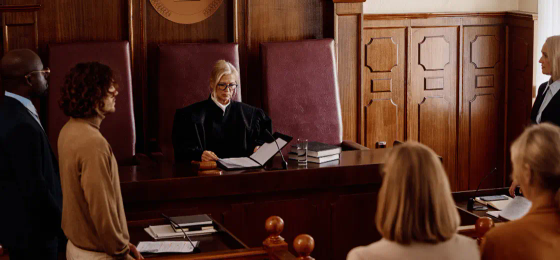The Defence of Duress in UK Criminal Law Explained

If you commit a crime because someone threatens your life, can you use that as a defence? In some situations, yes. But the defence of duress in UK criminal law is complex, limited, and tightly controlled by the courts.
Duress is a legal defence that applies when someone commits a crime because they were forced to do so under a real and immediate threat of death or serious injury. It recognises that people sometimes act under extreme pressure and have no realistic choice but to obey. However, it can only succeed if strict legal tests are met - and it’s not available for the most serious crimes such as murder.
In this guide, you’ll learn:
- What the defence of duress means in UK criminal law.
- The difference between duress by threats and duress of circumstances.
- The key legal tests courts use, including those from R v Graham and R v Hasan.
- When duress cannot be used as a defence.
- How duress compares with the related concept of necessity.
- Real-world case examples and what they show.
- How MMA Law’s criminal defence solicitors can help if you acted under threat or coercion.
Understanding this defence could make a vital difference to your case. The sections below explain how it works, and when it might apply.

What Is the Defence of Duress?
The defence of duress applies when a person commits a crime because they are genuinely afraid that refusing to do so will lead to death or serious injury to themselves or someone close to them. It recognises that in some extreme situations, human instinct for survival can override ordinary judgment.
There are two forms of duress in UK criminal law: duress by threats and duress of circumstances.
- Duress by threats occurs when another person directly threatens you to commit a crime - for example, “steal this car, or I’ll kill you.”
- Duress of circumstances arises when external events, rather than a person’s threats, force you to act unlawfully, such as: driving through a red light to escape an immediate danger.
The test for duress was first set out in R v Graham (1982) and later refined in R v Hasan (2005). It involves two key stages:
- Subjective test – Did the defendant honestly believe they or another person faced an immediate threat of death or serious injury?
- Objective test – Would a reasonable person of reasonable firmness, sharing the same characteristics, have acted in the same way?
If both parts are satisfied, duress can act as a complete defence, leading to an acquittal. However, the burden lies on the prosecution to disprove it once raised.
Despite this, duress is not an easy defence to succeed with. Courts examine the circumstances very closely - including the immediacy of the threat, the opportunity to escape, and whether the defendant voluntarily became involved with those making the threats. Because of these limits, it’s essential to get professional legal advice early.
If you believe duress played a part in your case, speak to our Criminal Defence Solicitors in Middlesbrough at MMA Law for clear, confidential guidance.
The Two Types of Duress in UK Law
Duress can arise in two distinct ways under UK criminal law:
- duress by threats
- duress of circumstances
Both rely on the same legal principles, but they differ in how the pressure is created.
Duress by Threats
Duress by threats occurs when another person directly threatens you with death or serious injury, forcing you to commit a criminal act. This is the most common form of duress and was central to the cases of R v Graham (1982) and R v Hasan (2005).
For the defence to apply, the threat must be immediate or almost immediate, leaving no reasonable opportunity to escape or contact the authorities. It is not enough to feel general fear or pressure - the danger must be real, serious, and specific.
Importantly, the threat does not have to be directed solely at the defendant. It can also apply if someone close to them, such as a family member or partner, was at risk.
Duress of Circumstances
Duress of circumstances arises not from a person’s threats, but from external situations that place the defendant under overwhelming pressure to break the law. A classic example is R v Martin (1989), where a man drove while disqualified because his wife’s life was in danger.
In these cases, the courts apply the same two-part test used in duress by threats - assessing both the defendant’s belief in the danger and how a reasonable person would have responded.
Both forms of duress are treated cautiously by the courts, and success depends on proving the immediacy of the threat and the absence of any safe alternative.

Legal Tests for Duress – How Courts Decide
Courts follow strict legal tests to decide whether the defence of duress applies. These principles come mainly from R v Graham (1982) and R v Hasan (2005), which together define how judges and juries must assess each case.
The Two-Stage Test
- Was the defendant compelled to act because they genuinely believed they or another person would face death or serious injury if they refused?
- Would a reasonable person of reasonable firmness, sharing the same characteristics, have acted in the same way?
The first stage is subjective, focusing on what the defendant honestly believed. The second stage is objective, considering how an ordinary, law-abiding person might have reacted in similar circumstances.
Conditions Clarified in R v Hasan (2005)
For the defence to succeed, the following criteria must all be met:
- The threat must involve death or serious injury — lesser threats are insufficient.
- The threat must be directed at the defendant, their immediate family, or someone close.
- The danger must be immediate or almost immediate, leaving no time to avoid it safely.
- The defendant must have no safe avenue of escape or reasonable opportunity to seek help.
- The defence cannot apply if the defendant voluntarily associated with criminals known to use violence or coercion.
Once raised, the burden of proof lies on the prosecution to disprove duress beyond reasonable doubt. However, the defendant must first present credible evidence to raise the issue.
Because the law around duress is narrow and complex, it’s vital to have expert legal representation. Our team specialise in building strong, evidence-based defences where coercion or threats played a role.
When Duress Cannot Be Used as a Defence
Duress is not available for the most serious crimes. The courts have made it clear that certain offences are so grave that no amount of threat can justify committing them.
The leading case is R v Howe (1987), where the House of Lords ruled that duress cannot be used as a defence to murder or attempted murder. The court reasoned that the law expects individuals not to take an innocent life, even when threatened with their own. This principle applies equally if the threat involves the life of a loved one or close family member.
Duress also cannot be used for certain forms of treason or serious offences that threaten national security. These exceptions reflect a long-standing public policy - the protection of life and the prevention of extreme harm to society.
Additionally, under R v Hasan (2005), the defence fails where the defendant voluntarily associates with violent or criminal individuals, knowing they might be pressured to offend. This “voluntary exposure” rule stops people from using duress as a defence when they willingly put themselves in dangerous criminal environments.
While these restrictions can seem harsh, they reflect the law’s view that allowing duress in such cases would undermine responsibility and public safety.
Even if duress cannot be argued, experienced defence solicitors can often explore related avenues (such as necessity or duress of circumstances) which may still apply depending on the facts.

Duress vs Necessity – What’s the Difference?
Duress and necessity are often confused, but they are distinct legal defences. Necessity applies when someone commits an unlawful act to avoid a greater harm, even without a direct human threat. Duress, on the other hand, involves acting under threats from another person.
The key differences are:
- Duress: Involves a human threat — immediate danger of death or serious injury.
- Necessity: Involves external circumstances — acting to prevent serious harm or disaster.
- Duress: Relies on compulsion by another person.
- Necessity: Relies on a choice between two evils.
An example of necessity might be a doctor performing an emergency procedure without consent to save a life, or a motorist breaking traffic laws to avoid an accident.
Both defences are rare and tightly controlled, as courts fear misuse. Cases like R v Martin (1989) and R v Dudley and Stephens (1884) show that only the most urgent, unavoidable situations qualify.
Frequently Asked Questions
What is the defence of duress in UK criminal law?
The defence of duress in UK criminal law applies when someone commits a crime because they were threatened with death or serious injury. It recognises that extreme threats can force people to act against their will. The courts use a two-part test from R v Graham (1982) to decide if the threat was genuine and if a reasonable person would have acted the same way. If successful, duress is a complete defence, leading to acquittal.
What are the two types of duress?
There are two types of duress in UK law: duress by threats and duress of circumstances. Duress by threats occurs when another person forces someone to commit a crime through direct threats. Duress of circumstances happens when external events (not people) create overwhelming pressure. Such as driving dangerously to escape harm. Both forms use the R v Graham (1982) two-part test and require proof of an immediate threat.
Can duress be used for murder charges?
No. The defence of duress cannot be used for murder or attempted murder. In R v Howe (1987), the House of Lords ruled that even if someone acts under threat of death, they cannot rely on duress to justify killing another person. The same principle applies to attempted murder and some forms of treason. Courts view these crimes as too serious to excuse, even under extreme coercion.
What is duress of circumstances?
Duress of circumstances applies when someone commits a crime because of external pressure, not direct threats from a person. For example, driving while disqualified to escape immediate danger could qualify. The defence was recognised in R v Martin (1989). Courts apply the same subjective and objective tests used for duress by threats - the danger must be real, immediate, and unavoidable.
What is the R v Hasan test for duress?
The R v Hasan (2005) test refined how courts apply duress. It confirmed that the threat must involve death or serious injury, be immediate or almost immediate, and leave no safe avenue of escape. The threat must be directed at the defendant or someone close to them, and the defence fails if the defendant voluntarily associated with criminals known for violence. These limits make duress a narrow but important defence.
Who decides if duress applies – judge or jury?
Whether duress applies is a question for the jury, but the judge decides if enough evidence exists to allow the defence to be considered. The judge first determines whether the evidence of threats or coercion meets the legal threshold. If it does, the jury decides whether they believe the defendant acted under genuine and immediate duress.
What if the threat was to someone else?
A threat to someone close to the defendant - such as a family member or partner - can support the defence of duress. The law recognises that people may act under pressure to protect loved ones. The threat must still meet the same conditions: it must be of death or serious injury, immediate, and inescapable. The R v Hasan (2005) case confirmed that these rules apply equally whether the threat is to the defendant or another person.
Is duress the same as necessity?
No. Duress involves threats from another person, while necessity involves external circumstances where breaking the law prevents greater harm. For example, duress may apply if you steal under threat, while necessity may apply if you break into a house to save someone from a fire. Both are rare and closely scrutinised, but necessity does not require a direct human threat.
What happens if the court rejects duress?
If the court rejects a duress defence, the case proceeds as normal. The defendant can still present mitigating factors at sentencing, such as acting under pressure or fear. While duress might not excuse guilt, it can sometimes reduce the penalty. A solicitor can also explore whether procedural errors or unlawful police conduct affected the fairness of the trial.

How MMA Law Can Help if You Acted Under Duress
Facing criminal charges after being threatened or coerced is an incredibly stressful experience. You may feel trapped, misunderstood, and unsure how to prove what really happened. At MMA Law, we understand the fear and confusion that come with such cases — and we’re here to help you take control.
Our specialist criminal defence solicitors have extensive experience representing clients who acted under duress or necessity. We will:
- Assess your case to determine whether the defence of duress or necessity applies.
- Gather supporting evidence, including communications, witness statements, or forensic data that supports your account.
- Analyse the prosecution’s case for inconsistencies and unlawful procedures.
- Present strong legal arguments in court using key case law such as R v Hasan and R v Graham.
- Negotiate with the Crown Prosecution Service (CPS) where appropriate to seek reduced charges or dismissal.
Our team has defended clients across the UK facing serious allegations where duress was a central issue. We approach every case with discretion, professionalism, and determination to achieve the best possible outcome.
If you acted under threat or pressure, don’t face it alone. Contact MMA Law today for a confidential, free 30-minute legal consultation with our criminal defence solicitors.
